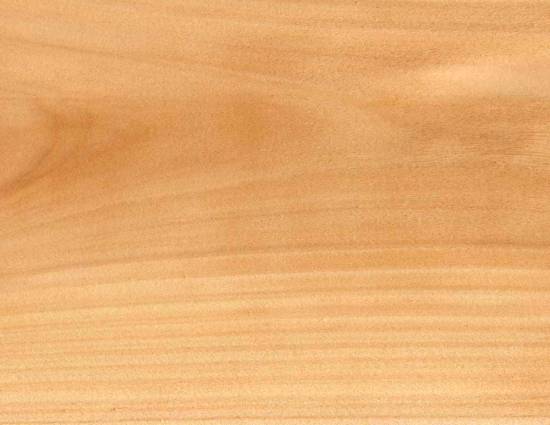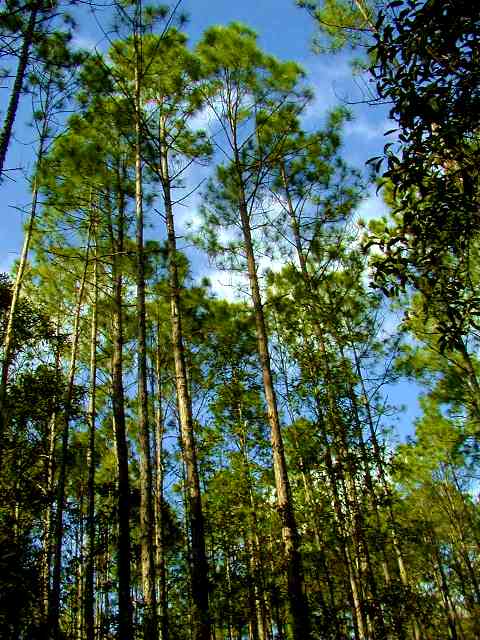Pinus Elliotis (Ellioti Pine)
Commom Uses: Moldings, furniture, handles, flooring, toys, construction
A pine is a coniferous tree of the genus Pinus, in the family Pinaceae. There are about 115 species of pine, although different authors accept anything from 105 to 125 species.
Classification: Pines are divided into three subgenera, based on cone, seed and leaf characters:
Subgenus: Strobus (white pines). Cone scale without a sealing band. Umbo terminal. Seedwings adnate. One fibrovascular bundle per leaf.
Subgenus: Ducampopinus (pinyon, lacebark and bristlecone pines). Cone scale without a sealing band. Umbo dorsal. Seedwings articulate. One fibrovascular bundle per leaf.
Subgenus: Pinus (yellow or hard pines). Cone scale with a sealing band. Umbo dorsal. Seedwings articulate. Two fibrovascular bundles per leaf.
General Information:
Pines are evergreen and resinous. The bark of most pines is thick and scaly, but some species have thin, flaking bark. The branches are produced in regular "pseudowhorls", actually a very tight spiral but appearing like a ring of branches arising from the same point. Many pines are uninodal, producing just one such whorl of branches each year, from buds at the tip of the year's new shoot, but others are multinodal, producing two or more whorls of branches per year. The spiral growth of branches, needles and cone scales are arranged in Fibonacci number ratios. The new spring shoots are sometimes called "candles"; they are light-colored and point upward at first, then later darken and spread outward. These "candles" offer foresters a means to evaluate fertility of the soil and vigour of the trees.
Foliage:
Pines have four types of leaves. Seedlings begin with a whorl of 4-20 seed leaves (cotyledons), followed immediately by juvenile leaves on young plants, 2-6 cm long, single, green or often blue-green, and arranged spirally on the shoot. These are replaced after six months to five years by scale leaves, similar to bud scales, small, brown and non-photosynthetic, and arranged like the juvenile leaves; and the adult leaves or needles, green (photosynthetic), bundled in clusters (fascicles) of (1-) 2-5 (-6) needles together, each fascicle produced from a small bud on a dwarf shoot in the axil of a scale leaf. These bud scales often remain on the fascicle as a basal sheath. The needles persist for 1.5-40 years, depending on species. If a shoot is damaged (e.g. eaten by an animal), the needle fascicles just below the damage will generate a bud which can then replace the lost growth.
Cones:
Pines are mostly monoecious, having the male and female cones on the same tree, though a few species are sub-dioecious with individuals predominantly, but not wholly, single-sex. The male cones are small, typically 1-5 cm long, and only present for a short period (usually in spring, though autumn in a few pines), falling as soon as they have shed their pollen. The female cones take 1.5-3 years (depending on species) to mature after pollination, with actual fertilization delayed one year. At maturity the cones are 3-60 cm long. Each cone has numerous spirally arranged scales, with two seeds on each fertile scale; the scales at the base and tip of the cone are small and sterile, without seeds. The seeds are mostly small and winged, and are anemophilous (wind-dispersed), but some are larger and have only a vestigial wing, and are bird-dispersed (see below). At maturity, the cones usually open to release the seeds, but in some of the bird-dispersed species (e.g. Whitebark Pine), the seeds are only released by the bird breaking the cones open. In others, the fire climax pines (e.g. Monterey Pine, Pond Pine), the seeds are stored in closed ("serotinous") cones for many years until a forest fire kills the parent tree; the cones are also opened by the heat and the stored seeds are then released in huge numbers to re-populate the burnt ground.
Pinus Elliotis Wood

Pinus Elliotis - Physical & Mechanical Properties:
PROPERTIES------------------------------COMPLEMENT-------------VALUE UNIT
Specific Gravity:---------------------------green wood-------------------1.130 g/cm³
Specific Gravity:---------------------------8% KD-------------------------0.510 g/cm³
Shrinkage:----------------------------------Radial---------------------------6.34%
Shrinkage:----------------------------------Tangential----------------------7.29%
Shrinkage:----------------------------------Longitudinal-------------------n/a
Shrinkage:----------------------------------Volumetric---------------------0.83%
Static bending (SAT):-------------------mod.of rupture---------------476 kgf/cm²
Static bending (SAT):-------------------mod.of elasticity------------106450 kgf/cm²
Compression strength (SAT):---------mod.of rupture---------------246 kgf/cm²
(parallel to grain)
Compression strength (SAT):---------mod.of elasticity------------109570 kgf/cm²
(perpend.to grain)
Compression strength (SAT):---------mod.of rupture---------------28 kgf/cm²
Compression strength (SAT):---------mod.of elasticity------------2803 kgf/cm²
Tension parallel to grain:---------------mod.of rupture---------------839 kgf/cm²
Tension parallel to grain:---------------mod.of elasticity------------163044 kgf/cm²
Tension perpend. to grain:--------------mod.of rupture---------------21 kgf/cm²
Tension perpend. to grain:--------------mod.of elasticity------------n/a
Janka hardness (SAT):-----------------------------------------------------222 kgf/cm²
Cleavage (SAT):---------------------------------------------------------------4.8 kgf/cm²
Toughness (SAT):------------------------------------------------------------1.45
kgf/cm²
Shear (SAT):-------------------------------------------------------------------71
kgf/cm²
(SAT) = SATURATED WOOD
Pinus Elliotis Trees

references:
(1) Farjon, A. 1984, 2nd edition 2005. Pines. E. J. Brill, Leiden. ISBN 90-04-13916-8
(2) Little, E. L., Jr., and Critchfield, W. B. 1969. Subdivisions of the Genus Pinus (Pines). US Department of Agriculture Misc. Publ. 1144 (Superintendent of Documents Number: A 1.38:1144).
(3) Richardson, D. M. (ed.). 1998. Ecology and Biogeography of Pinus. Cambridge University Press, Cambridge. 530 p. ISBN 0-521-55176-5
(4) Mirov, N. T. 1968. The Genus Pinus. Ronald Press, New York (out of print).
(5) http://www.ecofor.com.br/p-products.htm
(6) FSC Brasil
(7) Abimovel - Associação Brasileira das Indústrias do Mobiliário
(8) Gernandt, D.S., G. Geada López, S.O. Garcia and A. Liston. 2005. Phylogeny and classification of Pinus. Taxon 54(1):29-42.
(9) Liston, A,, W.A. Robinson, D. Pinero, and E.R. Alvarez-Buylla. 1999. Phylogenetics of Pinus (Pinaceae) Based on Nuclear Ribosomal DNA Internal Transcribed Spacer Region Sequences. Molecular Phylogenetics and Evolution 11(1):95-109.